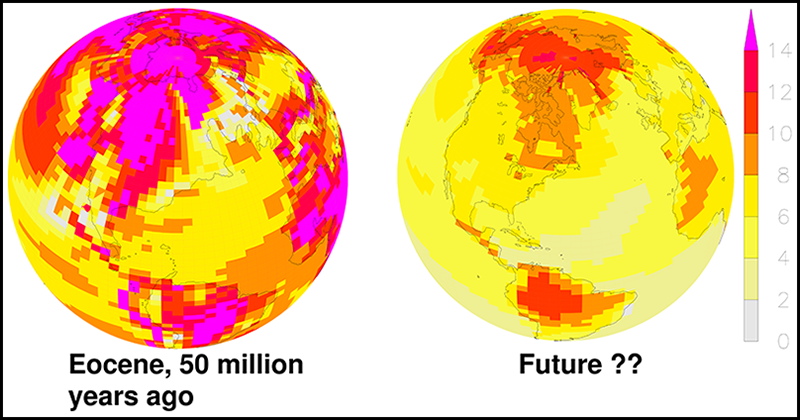Periods of climate extremes in Earth’s history provide an exciting natural laboratory in which to explore. As anthropogenic greenhouse gas emissions warm our planet, it becomes important to look to past periods of extreme warmth to challenge our understanding of the relevant mechanisms and to test our climate models.
To this end, 36 scientists from across the modeling-observational spectrum met at the National Center for Atmospheric Research to share their latest exciting research and to plan the Deep-Time Model Intercomparison Project (DeepMIP). This model-data intercomparison focuses on the superwarm early Eocene period (about 50 million years ago), when average yearly temperatures were as much as 10°C warmer than today.

DeepMIP—where “deep” refers generally to climates of the pre-Pliocene, more than 5.3 million years ago—is a working group within the larger Paleoclimate Modelling Intercomparison Project (PMIP), itself an official component of the Coupled Model Intercomparison Project Phase 6 (CMIP6). DeepMIP ultimately aims to evaluate state-of-the-art climate models under warm paleoclimate conditions, informing model developers and the Intergovernmental Panel on Climate Change.
The meeting began with a series of short talks in which all members were able to share their recent research. One of the most exciting revelations was the possibility of resurrecting previously discredited temperature records derived from measuring the oxygen-isotopic composition of calcite in the shells of microscopic marine surface-dwelling organisms, such as foraminifera. Many such records were thought to be rendered useless because of postdepositional changes in the calcite not connected to the original temperature (diagenesis). However, by making detailed measurements of single specimens in which microscopic regions of calcite are better preserved, such records might be remeasured. This measurement could ultimately provide a comprehensive global data set of sea surface temperatures during the superwarm climate of the early Eocene. Such a data set would be an invaluable tool for evaluating climate model simulations of this time period.
An experimental design, describing in detail the protocols for the model intercomparison, is under review for publication.
Another goal of the meeting was to come to a consensus on a model experimental design, describing in detail the experimental protocols for the intercomparison. This design, which was the main outcome of the meeting, is under review for publication in the journal Geoscientific Model Development.
Such discussions are normally carried out by the modeling community in isolation. However, the expertise of the data community present proved hugely useful, ensuring not only that the core model simulations would be as realistic as possible but also that associated sensitivity studies would fully reflect the uncertainty in our knowledge of the key forcings that made the Eocene so warm. In this regard, working groups were set up to focus on reconstructing atmospheric carbon dioxide levels, assessing uncertainty in paleogeography, and developing the marine and terrestrial data reconstructions.
The meeting highlighted the fact that our climate models are still not reproducing the level of high-latitude warmth seen unequivocally in the proxy records.
Finally, the meeting highlighted the fact that our climate models are still not reproducing the level of high-latitude warmth seen unequivocally in the proxy records. This is a decades-old problem in paleoclimate science. The challenge to the data community over the coming years of DeepMIP is to rigorously characterize the uncertainties in the proxy records, using multiple proxies where possible, and to target new records in undersampled regions.
The challenge to the modeling community is whether the recent increases in model resolution and in the scope and complexity of Earth system components and the improved process-based representation of processes such as convection will mean that, finally, our models will be able to recreate the superwarm climate of the Eocene. If they do, the scientific community’s confidence in future climate simulations will also increase.
—Daniel J. Lunt, School of Geographical Sciences, University of Bristol, Bristol, U.K.; email: [email protected]
Citation:
Lunt, D. J. (2016), Characterizing superwarm periods in Earth’s history, Eos, 97, https://doi.org/10.1029/2016EO056275. Published on 02 August 2016.
Text © 2016. The authors. CC BY-NC-ND 3.0
Except where otherwise noted, images are subject to copyright. Any reuse without express permission from the copyright owner is prohibited.

